
Ilfeld Auditorium will resonate with the music of Gabriel Urbain Fauré Nov. 16th at 3 p.m., when the New Mexico Highlands University Concert Choir presents A Fauré Festival. Under the baton of Andre Garcia-Nuthmann and accompanied on piano by Lydia Madrick, the choir will perform the Fauré Requiem, the Pavane in F Sharp minor Op. 50, and the Cantique de Jean Racine Op 11. Vocal soloists are soprano Karliz de Marco and baritone Devin Barad. One of Fauré’s best known works, the Messe de Requiem, written between 1887 and 1890, was an experiment in his quest to write innovative music. The Cantique de Jean Racine was written when Fauré was 19 years old and the text “Verbe égal au Tres-Haut” is a paraphrase by Jean Racine, a 17th-century dramatist and one of the most important literary figures in Western tradition. The Pavane in F sharp minor Op 50 was composed for orchestra and optional chorus in 1887. Originally written for orchestra, Faure dedicated the work to his patron Elisabeth, comtesse Greffulhe.Gabriel Fauré was born on May 12, 1845 in the southern French town of Pamiers and was the youngest of six children. At the age of 9, Fauré was sent to the new Niedermeyer School of Religious Music in Paris after his parents discovered his proclivity for music. There Niedermeyer took an interest in the young Fauré and helped him develop his skills.Music was a passion throughout Fauré’s life. During the Franco-Prussian War, Fauré gave impromptu recitals to his friends while housed in abandoned buildings outside of Paris. In 1877, with the help of such influential friends as Gounod and Saint-Saí«ns, Fauré took on a choirmaster position at the prestigious Madeleine of Paris where the rich and famous flocked for services. He was charged with organizing the music and directing the choir. Since there were no women performers allowed at that time, alto and soprano parts were sung by 20 boys who were so disagreeable that Fauré labeled them his “geese”. The church officials were often upset by Fauré’s choice of music. For the funeral of a well-known French architect, Fauré performed his Requiem and immediately after the ceremony the vicar demanded to know what this unknown Mass was. When he learned it was Fauré’s own composition, he stated that the church didn’t need these novelties as the Madeleine’s repertoire was quite rich enough.The Requiem conveys Fauré’s own feelings about death, as a joyful deliverance and an aspiration towards happiness beyond the grave. In an effort to break tradition, Fauré left out the Dies Irae and Benedictus texts common in requiems and inserted the Libera Me, a prayer for absolution, which usually follows the requiem mass, and the In Paradisum, which is usually spoken outside the church at the moment of burial. Unlike other requiems, the Fauré Requiem is sung for the dead. Different sections of the work showcase a unique understory of death and the ascension into Heaven. The opening movement represents the death of the actual body. In the following movements, the Kyrie and Offertory, angelic spirits guide the baritone solo, who symbolizes the deceased, as he makes his journey to Heaven. Audience members should listen closely to the piano accompaniment in the Sanctus, which personifies the fluttering of angel wings as the soul is borne upwards. The work centers on the Pie Jesu, where a soprano soloist represents the angel at the gates of Heaven and who guides the soul to God. The deceased meets with God during the mysterious Agnus Dei and there is a reiteration of the original theme where the soul realizes he has a new beginning. He begs in the Libera Me for God to free his spirit from the agony of death. Following that, the In Paradisum represents a choir of angels who welcome the soul. In 1896, Fauré became the professor of composition at the Paris Conservatoire. His class included Ravel among other well known composers. In 1905 Fauré became the director of the Paris Conservatoire, the most prestigious music position post in Paris.In 1902, Fauré began to suffer from hearing loss so his late works were written almost entirely without the help of a piano. His last years included an increase in hearing and health problems. During this time he composed the brilliant piano trio in 1922 and the string quartet in 1924. Faure died of pneumonia at the age of 79 in 1924. His funeral was held at the Madeleine and his Requiem was played.Tickets are $10 for the general public, $5 for seniors, faculty and staff and free for students with ID. For more information call the music department at 454-3135 or 454-3359.
